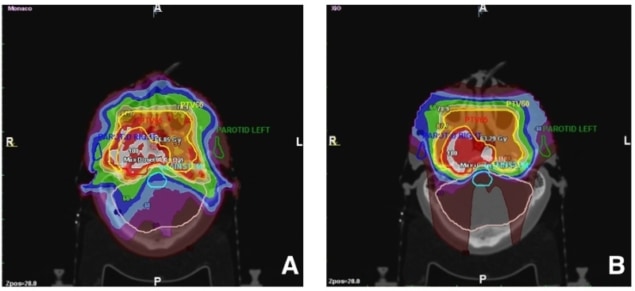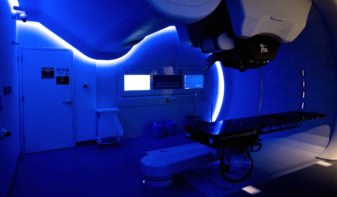
The Christie in Manchester is the site of one of the UK’s two new NHS-funded high-energy proton therapy centres, and will start treating patients this autumn. It will also play host, in its research room, to one of the most complex medical imaging systems ever developed – a scanner that uses proton beams to create 3D images of the internal anatomy of cancer patients.
Currently, proton treatments are planned based upon X-ray CT images of the patient. However, the required conversion of Hounsfield units to proton stopping power is a major source of inaccuracy. Proton CT images, on the other hand, provide a direct measure of proton stopping power, reducing this uncertainty and enabling more accurate tumour targeting. Having proton imaging in the treatment room also enables changes in a patient’s anatomy to be monitored throughout the course of treatment, with a view to adaptive proton therapy.

The scanner is being developed by the OPTIma (Optimising Proton Therapy through Imaging) project, funded by a £3.3 million grant from the UK’s EPSRC and led by Nigel Allinson from the University of Lincoln. OPTIma builds on previous work by Allinson and his team on the PRaVDA project, which constructed the first fully solid-state prototype proton imaging system and last year produced clinical-quality proton CT images of biological tissue (see: Proton CT moves closer to the clinic).
For this latest proton CT scanner, the OPTIma team has to address several design considerations, such as increasing the scannable area up to 40 cm2. “It is costly and impractical to construct an instrument with such a large aperture – and inefficient too,” said Allinson. “Our solution is to use small sensors that are synchronized to pencil-beam movement. Simulations and experimental work indicate that higher quality imagery is possible with a small spot rather than a broadened beam.”
Imaging with the pencil-beam generated by The Christie’s ProBeam proton therapy system presents its own challenges, however. These include dealing with a higher proton flux in the beam spot and, as the sensor moves to remain centred on the spot, ensuring that the sensor lifetime is not affected by radiation damage.
To achieve this, the OPTIma detectors are based on the same type of silicon microstrip sensors used in the ATLAS experiment at the Large Hadron Collider. “The high rate of protons needed to deliver the required dose in the required timeframe makes it important to have very fast detectors, as well as detectors that can withstand the accumulated dose over many years of operation,” explained Phil Allport, from University of Birmingham and the ATLAS experiment at CERN, who is leading the proton beam detector element of the project.
Allinson notes that new scanner was designed with an emphasis on reducing cost and complexity, and providing much faster calibration and set-up times. The system also requires the ability to operate for widely different time structures of the proton beams, and to produce calibrated proton radiograms in real-time.
The proton CT scanner will be used initially for research. “There is a full range of experiments to do – optimizing all instrument parameters, imaging complex phantoms and biological samples and use in very accurate calibration of clinical phantoms to enhance quality control on existing proton therapy sites,” said Allinson. “There will also be ‘dummy runs’ on clinical planning, as we need to understand the workflows in an operational centre.”
The project at The Christie will begin later this year, and will be the first time that a proton imaging system is installed in an operational proton therapy centre. “We will start in September 2018 and then it will take about two years to design, build and test. So we’re probably looking at installation in the last quarter of 2020,” Allinson told Physics World.



